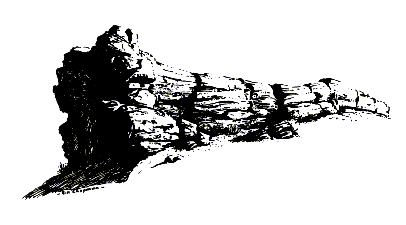Puerco Pueblo

Imagine a large basin area with numerous rivers and streams flowing through lowland. A lush landscape with coniferous trees up to nine feet in diameter and towering almost two hundred feet tall surrounds you. Ferns, cycads and giant horsetails grow abundantly along the waterway, providing food and shelter for many insects, reptiles, amphibians, and other creatures.
During the Triassic Period (200 - 250 million years ago) the Colorado Plateau area of northeastern Arizona was located near the equator and on the southwestern edge of the landmass known as "Pangea". (Eventually this super-continent separated to create our present continents.) This tropical location resulted in a climate and environment very different from today. Fossil evidence of this ancient land lies in the sediments called the Chinle Formation that is now exposed in Petrified Forest National Park.
 Araucarioxylon arizonicum
Araucarioxylon arizonicum
Over time, trees died or perhaps were knocked over by floodwaters or wind. Rivers carried the trees into the lowlands, breaking off branches, bark, and small roots along the way. Some trees were deposited on the flood plain adjacent to the rivers and others were buried in the stream channels. Most of the trees decomposed and disappeared. But a few trees were petrified, becoming the beautiful fossilized logs we see today. Most of the fossilized logs are from a tree called Araucarioxylon arizonicum. Two others, Woodworthia and Schilderia, occur in small quantities in the northern part of the park. All 3 species are now extinct.
Petrification:
Some logs were buried by sediment before they could decompose while volcanoes
to the west spewed tons of ash into the atmosphere. Winds carried ash into
the area where it was incorporated into the deepening layers of sediment.
Ground water dissolved silica from the volcanic ash and carried it through
the logs. This solution filled, or replaced cell walls, crystallizing as the
mineral quartz. The process was often so exact that replacement left a fossil
that shows every detail of the logs? original surfaces and, occasionally, the
internal cell structures. Iron rich minerals combined with quartz during the
petrification process, creating the brilliant rainbow of colors.
 Uplift and Erosion:
Uplift and Erosion:
Over time, this area has endured many changes. About 60 million years ago, after the Chinle Formation was deeply buried by younger strata, the region was uplifted as part of the massive Colorado Plateau. As time passed, many rivers and storms eroded the land, removing the layers of rock until, again, the Chinle Formation was exposed. Now fossilized logs lie strewn across the clay hills and are exposed in cliff faces. Most logs are broken into segments. Humans did not cut the logs. Because the sections are still in order, we know that the logs fractured after they were buried and the petrification process was complete. Since petrified logs are composed of quartz, they are hard and brittle and break easily when subjected to stress. Earthquakes or the gradual lifting of the Colorado Plateau may have produced such stress
Petrified wood is found in every state and in many countries, so why was this place made a national park? It was originally established to protect some of the largest and most beautifully preserved concentrations of petrified wood in the world. We now know, however, that few places in the world have a fossil record of the Triassic Period that is so diverse and complete.
Today all natural and cultural resources such as petrified wood, rocks, fossils, artifacts and plants must not be disturbed or removed. Unfortunately, in spite of severe penalties, written and verbal warnings and the opportunity to legally obtain petrified wood, thoughtless visitors continue to steal over one ton each month. (Petrified wood sold in local shops does not come from the park. It is obtained from private lands outside the park boundaries.)